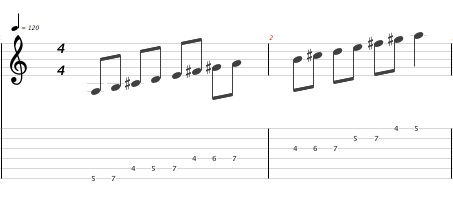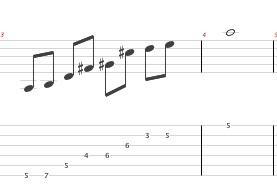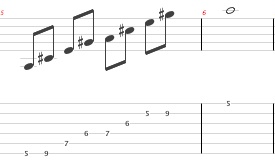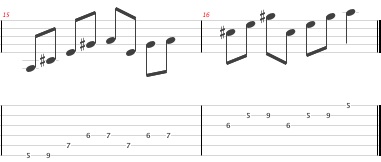When Sweep Picking Gets Old, Try This

Sweep picking was invented a long time ago, and it's been used in many amazing guitar solos.
Where would the Eighties be without sweep picking? Where would heavy metal be without it?
While we're all thankful for it and love doing it, sweep picking isn't a very surprising sound anymore.
So when you're crafting a solo and trying to make a lick that will give the same wonderful feel of sweeping, try these “2-1's” instead. They'll make you jump.
This 2-1 technique is very guitar oriented and originates from the two octave “across the neck” shapes.
EXAMPLE 1 is what I'm talking about; it's usually the first way you learn A Ionian. Keeping within this scale shape is important as the technique relies on it.

The whole point of the 2-1 technique is to pick two notes from one string, then one from the next string, two from the next, etc. EXAMPLE 2 is a good example of getting started with this technique. It avoids the sometimes awkward fingerings that can arise from trying more complicated ones.
Try running this shape front to back. Sometimes when you're faced with 4th intervals (like G# and C# in EXAMPLE 2) instead of barring your finger across the strings the way you would when sweeping, it's better to use one finger for each note (usually middle and ring or ring and pinky).

EXAMPLE 3 requires a bit more of a stretch and is a very clear A major 7 arpeggio. Despite the stretch, it's one of my favorite ways to play an A major 7, especially fast.

EXAMPLE 4 is a way to build a longer lick out of the same shapes, which brings me to the next issue.

Unlike sweeping, this technique can be hard to play fast up and down repeatedly. That's one of the things I like about it. Once you've practiced sweeping a lot, it can be easy to zone out and just play up and down as fast as you can. No matter how much you practice this it lends itself less to repetition and more as a way to connect melodic ideas.
EXAMPLE 5 is a nice example of a simple melodic idea connected by this 2-1 technique. First we have the little melody in one octave, drop it to a lower octave, and then build all the way up two octaves higher. It ends up being a bit more of a surprising and harmonically rich connecting idea than just a E major sweep to the melodic idea. Also a quick tip, the slide from the F# to the G# is best with your pinky.

If you have questions, feel free to leave them in the comments section below or reach out to me at my YouTube channel here.
Elliott Klein is a New York City-based guitarist/singer/songwriter who plays in Bright and Loud, Party Lights and many more.
Get The Pick Newsletter
All the latest guitar news, interviews, lessons, reviews, deals and more, direct to your inbox!










